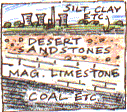 |
East Yorkshire LandscapesSunday 26th August 2001, East Yorkshire |
![]()
![]()
![]()
![]()
![]()
![]() This Month
Rocks
History
Workshop
Links
Home Page
This Month
Rocks
History
Workshop
Links
Home Page
![]()
 WE RARELY get out into East Yorkshire, the county formerly known as North Humberside and before that as the East Riding of Yorkshire. In Winifred Holtby's novel of the 1930s it becomes the South Riding. I hope they've made their mind up once and for all this time.
WE RARELY get out into East Yorkshire, the county formerly known as North Humberside and before that as the East Riding of Yorkshire. In Winifred Holtby's novel of the 1930s it becomes the South Riding. I hope they've made their mind up once and for all this time.As we head east along the M62 it's the cooling towers of Drax and Eggborough that dominate the flat landscape, which is underlain by soft Triassic rocks, dating from a time when desert conditions prevailed in Britain. However there's very little to be seen of these sandstones in this part of Yorkshire because they're almost entirely covered by clay, peat
 and silt. During the last glacial period, some 18,000 years ago, ice sheets filled the North Sea. Meltwaters from glaciers to the north ponded up to form Lake Humber which flooded over the Vale of York.
and silt. During the last glacial period, some 18,000 years ago, ice sheets filled the North Sea. Meltwaters from glaciers to the north ponded up to form Lake Humber which flooded over the Vale of York.The power stations are a reminder of even older rocks that lie concealed beneath the Triassic desert sediments. The seams in the Selby Coalfield are the remnants of tropical forest that grew here 300 million years ago. Between the coal and the desert sandstones there's the Magnesian Limestone, dating from a time around 250 million years ago when a dying sea, the Zechstein, covered much of Yorkshire.
It must be all that work at Brimham that is bringing my research on Yorkshire Rock to mind again.
Prehistoric East Yorkshire
Just to go over that again, in chronological order;- 300 million years ago; tropical forests form coal
- 250 million years ago; magnesian limestone forms in the dying Zechstein Sea
- 225 million years ago; soft red desert sandstones
- 95 million years ago; chalk forms in clear tropical seas
- 18,000 years ago; Lake Humber and the ice age glaciers
![]()
Richard Bell,
wildlife illustrator
E-mail; 'richard@willowisland.co.uk'
![]() Next page
Previous page
This day last year
This month
Nature Diary
Home Page
Next page
Previous page
This day last year
This month
Nature Diary
Home Page
![]()